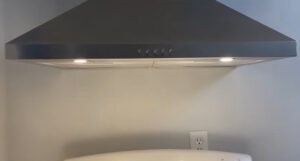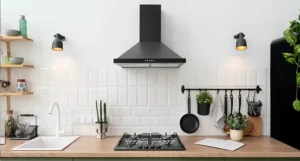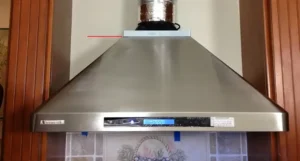Range hoods are necessary in every home. They not only keep your home free of the cooking smell but also free of fumes, heat, grease, and smoke.
Most of the time a range hood will vent from its own output vent. It can be redirected from the wall beside the stove, or from the ceiling.
But what happens if you already have a chimney in your home? Can a range hood vent into a chimney?
Well, it actually can. You can vent your range hood into your existing chimney. But there are some safety regulations you have to follow along with conducting the stability of the chimney before you proceed. And we are going to talk you through it.

Range Hood Venting Into The Chimney | Things To Keep In Mind
There is nothing bad about venting a range hood through the chimney. Even the National Fire Protection Standard (NFPS) states, ‘The hood shall be exhausted directly through an outside wall to the outside or connected to a suitable chimney flue used for no other purpose’. (NFPS:10.7.2.4.6)
So with the laws out of the way, there are other things you have to keep in mind. You already get the idea that your chimney should not be used for any other purpose like wood fire or warmth before you can use it as a range hood vent. And here are the other things that you should keep in mind.
The Size Of The Chimney Should Be Adequate
Size is key. If your chimney is too small or too wide, and your range hood vent doesn’t fit somehow or wable around, you cannot use it. The best course of action here is to ask a professional to inspect if you can use the chimney for your desired range hood.
If the range hood you choose is not the right size, you can go for another one that will fit the chimney. So consult with the professional before buying the range hood.
Is The Chimney Fit For Work? (Damage Or Crack Free)
Unused chimneys wild develop cracks. Sometimes the wall of the chimney is damaged due to weather and poor cleaning conditions. So, make sure it is fixed or replaced before you start using it as a vent. Consulting with an expert is always the best course of action.
Vent Pipes Should Be Sealed
Chimneys are made to vent smoke and fumes out of your home. So you can just vent the range hood without any pipes in it, right? Wrong!
You should always use venting pipes and run them toward the end of the chimney to vent the range hood. Keep in mind, that range hoods and a fireplace are different. While wood fires or gas burners cause soot, smoke, and fume, a range hood vents grease, oil, and other harmful substances that tend to cause fire. If the buildup keeps on going inside the chimney walls, it will eventually catch fire. And we don’t want that to happen.
Cleanliness Is The Key To Avoiding Fire
Always clean your range hood vents regularly as instructed. And make sure the chimney gets cleaned too. You don’t want a crow’s nest inside it or some squirrel to build a home sweet home in it. It is the fire we are dealing with, so take it seriously.
FAQs – Frequently Asked Questions and Answers
Where should a range hood be vented?
Range hoods should be vented out of your home. It can be either through the wall or the ceiling. If you have an unused chimney it is not damaged and fit your range hood vents. Never vent a hood inside the attic at any cost.
Can a range hood vent through the roof?
Yes. Range hood vents either go through the wall or the roof and vent from the top of the building.
Is it OK to vent your range hood into the attic?
No. Range hoods should never be vented into an attic. As it is a closed space, you will not only damage your home but also might cause a fire.
Conclusion
If all of the options mentioned above check out, you can go ahead and proceed to install your range hood vent into your chimney. Make sure to use the right venting pipes and duct sealing while you are at it. And cleaning always keeps you safe.



